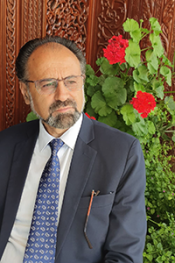The brush is mightier: One man’s mission to rescue art from the Taliban

In this painting by Dr. Mohammad Yousof Asefi, titled "Hopeless," four women cry outside the closed gates of a school on the first day Afghan girls were denied entry under the Taliban regime.
Amid the horrors of war, survival needs often eclipse all else. But for Dr. Mohammad Yousof Asefi, a practicing physician and nationally recognized artist, saving Afghanistan’s art was as critical as saving lives.
Under the Taliban’s iron-fisted rule, Asefi risked his life to protect his country’s cultural heritage — a mission he continues as artist-in-residence at the Center for the Study of Religion and Conflict at Arizona State University.
An upcoming Humanities Week event, “The Brush is Mightier: One Man’s Mission to Rescue Art from the Taliban,” will immerse the audience in Asefi’s remarkable story.
Asefi’s life changed forever when the Taliban seized control of Afghanistan in 1996. The regime’s rigid interpretation of Islamic law banned depictions of living beings in art. This policy led to the destruction of countless works of art and threatened Afghanistan’s rich cultural history. When the Taliban announced they would destroy paintings in the Afghan National Gallery, Asefi resolved to save them.
His daring plan to protect Afghanistan’s cultural heritage was as clever as it was dangerous. While a trusted colleague stood watch, Asefi carefully added layers of watercolors to temporarily hide human and animal figures in over 120 oil paintings. Despite knowing he risked death if discovered, his determination to save his country’s artistic treasures never wavered.
Where the Taliban’s rigid religious interpretation led to death and destruction, Asefi’s belief that art and creativity can coexist with faith became a source of healing and resilience.
“Throughout history, art has served as a profound expression of faith, transcending the boundaries of time and society,” Center for the Study of Religion and Conflict Director John Carlson said. “In times of oppression, artists have wielded their creativity as a powerful form of resistance. Art becomes a sacred act, challenging injustice, igniting hope and illuminating the resilience of the human spirit.”
After the fall of the Taliban in 2001, Asefi played a key role in Afghanistan’s cultural revival by helping restore the paintings he had altered and opening a public gallery in Kabul to make art accessible to all.
Open house event
What: “The Brush is Mightier: One Man’s Mission to Rescue Art from the Taliban,” a gallery open house with live painting.
When: 3–7 p.m. Thursday, Oct. 24.
Where: West Hall, Room 135, Tempe campus.
Admission: Free and open to all. Register here.
When the Taliban returned to power in 2021, Asefi was forced to flee Afghanistan, seeking refuge with his family in the United States. Settling in Arizona, Asefi continues his mission as artist-in-residence at the Center for the Study of Religion and Conflict.
“Under the Taliban’s occupation of Afghanistan, I was silenced, unable to express my art freely,” Asefi said. “But since coming to the United States and joining the Center for the Study of Religion and Conflict, I have regained my voice. Here, I can finally share my passion and creativity with the world, unbound by the restrictions that once held me back.”
Tom Mallon, a donor to the center’s visiting scholars fund, underscores the importance of bringing scholars like Asefi to ASU.
“Dr. Asefi is the bravest man I’ve ever met,” Mallon said. “In standing up to the Taliban, this gentle, merry painter repeatedly risked his life on behalf of free artistic expression.
“I became acquainted with him in 2005 when I went to Kabul, and he made a deep impression on me. Sixteen years later, when the Taliban retook control of Afghanistan, I knew that he and his family were in grave danger and the visiting scholars fund could help bring them to safety in America.
“Dr. Asefi’s presence on campus gives students a chance not only to see an accomplished artist at work but also to be inspired by a man who fought for the liberty essential to every artist and every citizen of the world.”
Asefi’s saga reflects the spirit of the humanities, highlighting the importance of understanding religion, conflict and art as essential to the human experience.
The Center for the Study of Religion and Conflict invites the public to become part of Asefi’s continuing story at an open house on Oct. 24. Attendees can enjoy hors d’oeuvres, watch Asefi create two new works and explore a showcase of paintings both smuggled out of Afghanistan and painted after he arrived in Arizona.
More Arts, humanities and education

ASU professor's project helps students learn complex topics
One of Arizona State University’s top professors is using her signature research project to improve how college students learn science, technology, engineering, math and medicine.Micki Chi, who is a…

Award-winning playwright shares her scriptwriting process with ASU students
Actions speak louder than words. That’s why award-winning playwright Y York is workshopping her latest play, "Becoming Awesome," with actors at Arizona State University this week. “I want…

Exceeding great expectations in downtown Mesa
Anyone visiting downtown Mesa over the past couple of years has a lot to rave about: The bevy of restaurants, unique local shops, entertainment venues and inviting spaces that beg for attention from…


